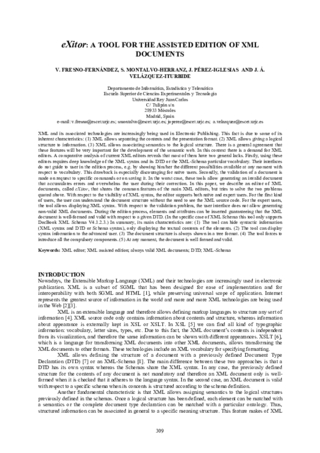XML and its associated technologies are increasingly being used in Electronic Publishing. This fact is due to some of its inherent characteristics: (1) XML allows separating the contents and the presentation format. (2) XML allows giving a logical structure to information. (3) XML allows associating semantics to the logical structure. There is a general agreement thatthese features will be very important for the development of the semantic web. In this context there is a demand for XML editors. A comparative analysis of current XML editors reveals that most of them have two general lacks. Firstly, using these editors requires deep knowledge of the XML syntax and its DTD or the XML-Schema particular vocabulary. Their interfaces do not guide to user in the edition process, e.g. by showing him/her the different possibilities available at any moment withrespect to vocabulary. This drawback is especially discouraging for naïve users. Secondly, the validation of a document is made on request to specific commands or on saving it. In the worst case, these tools allow generating an invalid document that accumulates errors and overwhelms the user during their correction. In this paper, we describe an editor of XMLdocuments, called eXitor, that shares the common features of the main XML editors, but tries to solve the two problems quoted above. With respect to the visibility of XML syntax, the editor supports both naïve and expert users. For the first kind of users, the user can understand the document structure without the need to see the XML source code. For the expert users, the tool allows displaying XML syntax. With respect to the validation problem, the user interface does not allow generatingnon-valid XML documents. During the edition process, elements and attributes can be inserted guaranteeing that the XML document is well-formed and valid with respect to a given DTD. (In the specific case of XML Schema this tool only supports DocBook XML Schema V4.1.2.3.) In summary, its main characteristics are: (1) The tool can hide syntactic information (XML syntax and DTD or Schema syntax), only displaying the textual contents of the elements. (2) The tool can display syntax information to the advanced user. (3) The document structure is always shown in a tree format. (4) The tool forces to introduce all the compulsory components. (5) At any moment, the document is well formed and valid.
Fresno-Fernandez, V., S. Montalvo-Herranz, and J. Pérez-Iglesias. "eXitor: A Tool for the Assisted Edition of XML Documents." In From information to knowledge: Proceedings of the 7th ICCC/IFIP International Conference on Electronic Publishing. ELPUB. Minho, Portugal: Universidade do Minho, 2003.
